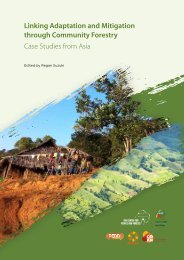Desktop Study on - Regional Climate Change Adaptation ...
Desktop Study on - Regional Climate Change Adaptation ...
Desktop Study on - Regional Climate Change Adaptation ...
You also want an ePaper? Increase the reach of your titles
YUMPU automatically turns print PDFs into web optimized ePapers that Google loves.
Assessment of Capacity Gaps and Needs of South East Asia Countries<br />
in Addressing Impacts, Vulnerability and Adaptati<strong>on</strong> to <strong>Climate</strong> Variability and <strong>Climate</strong> <strong>Change</strong><br />
2007). 30% of the cycl<strong>on</strong>es passing<br />
the Philippines are c<strong>on</strong>sidered<br />
destructive (RMSI, 2007). Table 6<br />
show the top five natural disasters<br />
– with respect to the number of<br />
people affected. Also, over all the<br />
natural hazard events c<strong>on</strong>cerning<br />
climatic disasters, i.e. storms,<br />
draughts and floods, between 1980<br />
- 2009, storms were resp<strong>on</strong>sible<br />
for 84% of all the people affected<br />
(see Figure 18) and 83% of all the<br />
ec<strong>on</strong>omic damages caused (see<br />
Figure 19) within this time period.<br />
Table_6<br />
Overview <strong>on</strong> natural disasters in the<br />
Philippines from 1980 to 2009<br />
Top 5 Natural Disasters in the Philippines, 1980-2009<br />
Type of natural<br />
disaster<br />
Date/year<br />
Storm Nov 1990 6,159,569<br />
Storm Jun 2008 4,785,460<br />
Storm Sep 2009 4,321,149<br />
Storm Oct 1998 3,902,424<br />
Storm Sep 2006 3,842,406<br />
No of people<br />
affected<br />
Fluctuati<strong>on</strong> in the seas<strong>on</strong>al rainfall<br />
distributi<strong>on</strong> is observed in the<br />
Philippines. This is <strong>on</strong>e of the<br />
distinctive effects of the El Niño<br />
Southern Oscillati<strong>on</strong> (ENSO)<br />
phenomen<strong>on</strong> that is associated<br />
with ENSO warm (cold) events.<br />
For the decades between 1950 and<br />
2005, seven El Nino and La Nina<br />
episodes have occurred exhibiting<br />
certain climatic changes. For<br />
example, the seas<strong>on</strong>al rainfall<br />
resp<strong>on</strong>se to ENSO turned sign<br />
between boreal summer (July<br />
- September) and fall (October -<br />
December) for both, El Niño and La Niña. <strong>Change</strong>s<br />
in the large-scale m<strong>on</strong>so<strong>on</strong> system occurred during<br />
the ENSO events that brought drought and flood<br />
c<strong>on</strong>diti<strong>on</strong>s (Ly<strong>on</strong> et al., 2006, cited in RMSI, 2007).<br />
Meanwhile, significant decrease in the number of<br />
Figure 19: Percentage of damage (US$)<br />
due to total natural disasters<br />
1980-2009<br />
Flood 16%<br />
Total Natural* Disasters in the Philippines for the period 1980-2009<br />
Type of<br />
natural<br />
disaster<br />
Total no of<br />
events<br />
No of<br />
people<br />
affected<br />
Damage<br />
000 US$<br />
Storm 192 90,765,856 5,045,830<br />
Drought 7 6,549,542 64,453<br />
Flood 84 10,546,024 981,557<br />
*not c<strong>on</strong>sidered are earthquake, epidemic, insect infestati<strong>on</strong>, wet or dry mass<br />
movement, volcano, and wildfire<br />
Source: EM-DAT (2009) The OFDA /CRED; Internati<strong>on</strong>al Disaster Database; www.emdat.net<br />
- Université Catholique de Louvain – Brussels, – Belgium.<br />
rain days is observed in some areas since 1961<br />
throughout Southeast Asia (Mant<strong>on</strong> et al., 2001,<br />
cited in GRID-Arendal, 2003).<br />
Sea levels have risen partly due to local subsidence<br />
particularly in the Manila area and partly due to<br />
global sea level rise (Hulme and Sheard, 1999, cited<br />
in ADB, 2009c).<br />
<strong>Climate</strong> Projecti<strong>on</strong>s<br />
<strong>Climate</strong> change is expected to exacerbate existing<br />
climatic hazards by creating more flood, drought,<br />
and storm events (val Aalst, 2006, cited in RMSI,<br />
2007).<br />
Drought 1%<br />
Storm 83%<br />
<strong>Climate</strong> change projecti<strong>on</strong> studies show that<br />
temperatures are expected to rise by 2.2 °C by<br />
the last quarter of the 21st century (World Bank,<br />
2005). In additi<strong>on</strong>, not <strong>on</strong>ly are rainfall patterns and<br />
substantial sea level rise projected, but also changes<br />
in climate variability and extreme weather events are<br />
anticipated to entail higher intensity in rainfall, hot<br />
spells and m<strong>on</strong>so<strong>on</strong> rainfall variability (Amadore,<br />
2005). Moreover, peak wind and precipitati<strong>on</strong><br />
intensity of tropical cycl<strong>on</strong>es are likely to increase in<br />
some areas of the Philippines (ibid).<br />
55

















